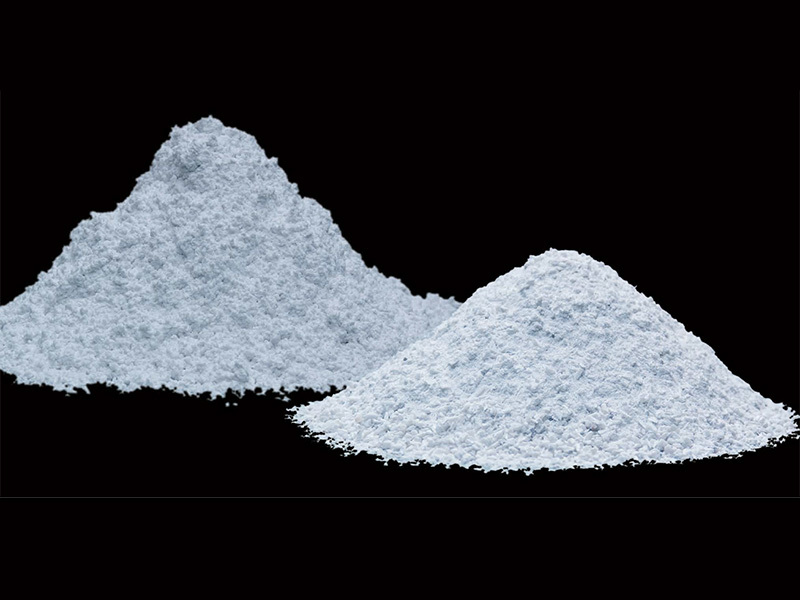Application and research of modified wollastonite

Wollastonite is an extremely important non-metallic mineral. Its main chemical composition is calcium metasilicate (CaSiO3). It belongs to the trigonal crystal system and is gray-white. Wollastonite has a large aspect ratio, a natural needle-like structure, and stable performance, making it an excellent reinforcing material. In addition to its natural fibrous structure, wollastonite also has extremely low oil absorption, electrical conductivity and dielectric loss. It is widely used in plastics, rubber, paints, coatings and other fields, and can significantly improve the mechanical and tribological properties of the matrix. Improve the thermal stability and dimensional stability of products.
However, natural wollastonite is hydrophilic, and when blended with organic polymers, the dispersion is uneven due to different polarities, thus reducing the mechanical properties of its filled products. In order to improve its dispersion and compatibility in organic matrices, as well as the mechanical properties of products, wollastonite often needs to be surface modified.
Wollastonite modification technology
The surface modification technology of wollastonite can be divided into: organic surface modification and inorganic surface modification.
For organic surface modification, commonly used surface modifiers include silane coupling agents, titanate and aluminate coupling agents, surfactants, and methyl methacrylate. Among them, silane coupling agent modification is one of the commonly used surface modification methods for wollastonite powder, and dry modification process is generally used. The dosage of coupling agent is related to the required coverage and the specific surface area of the powder. The dosage is generally 0.5% to 1.5% of the wollastonite mass.
The technical background of inorganic surface modification is that wollastonite as a polymer filler often causes the filler material to become darker in color, has a larger wear value, and easily wears processing equipment; inorganic surface coating modification can improve the silicone Gray stone fiber fills the color of polymer materials and reduces their wear value. At present, the inorganic surface modification of wollastonite mineral fibers mainly uses chemical precipitation method to coat the surface with nanometer calcium silicate, silica and nanometer calcium carbonate.
Application and research of modified wollastonite
(1) Plastic
Polypropylene (PP), as one of the five general-purpose plastics, has better comprehensive properties than other general-purpose plastics. It is increasingly widely developed and used in the fields of automobiles, aerospace, construction and medicine.
(2) Papermaking
The application of wollastonite in the paper industry is quite different from other fillers. It is not a simple filling like traditional fillers. It mainly relies on a higher aspect ratio to realize the interweaving of wollastonite and plant fibers to form plant fibers. The network structure of fiber-mineral fiber can replace some short fibers of plants, which can effectively improve the opacity and printing adaptability of produced paper, improve uniformity and reduce manufacturing costs.
(3) Friction materials
Wollastonite products for friction materials are wollastonite needle-like powders. Compared with traditional application scenarios, they are mostly used as fillers in brake pads, clutches, etc. The acicular powder of wollastonite is an ideal substitute for short fiber asbestos. It can improve the stability of friction materials, reduce cracking, improve wear resistance and recovery properties and other mechanical properties to a certain extent.
(4) Coating
Wollastonite can be used as an extender pigment and a partial substitute for white pigments in paints. In addition, according to the characteristics of wollastonite itself, it can also be used as a coating modification additive to expand the functionality of the material. For example, wollastonite has good corrosion resistance and can be widely used in the field of anti-corrosion coatings.
(5) Rubber
In the rubber industry, wollastonite powder can replace part of titanium dioxide, white carbon black, clay, light calcium, lithopone and other materials, play a certain reinforcing effect, and can improve the hiding power of some colorants.
(6) Cement/fiber reinforced concrete
Fibrous wollastonite replaces short asbestos fibers and glass fibers and is added to cement, concrete and other building materials, which can improve the impact resistance, bending strength, wear resistance and dimensional stability of the materials.
